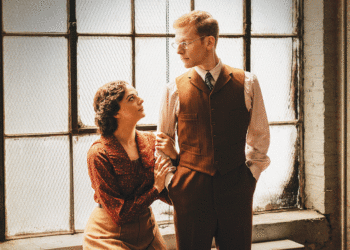Reviewed by NEAL GENDLER
“I ought not to be here.”
More than a decade into a prosperous, busy life in a lovely house with three children, the voice in Lien’s head kept growing louder and more persistent.

Lien, a hidden Jewish orphan of the Shoah, realized she was older than her mother, who at 29 walked hand in hand with Lien’s grandmother to death.
Lien’s past loomed ever darker, draining joy from her marriage to a chemist who’d survived in hiding with his family.
She felt “she should have died in Auschwitz alongside all the others” — almost all her extended family — says Dutch-born Oxford English-literature professor Bart van Es. His grandparents’ wartime and postwar sheltering of Lien in Dordrecht led to Cut Out Girl.
Jannigje and Hendrik van Es had taken in Hesseline (Lien) de Jong, almost 9, like a daughter. They did this after her parents, who would die in Auschwitz, gave her for hiding in August 1942.
Van Es says he knew that his grandparents had sheltered Jews but little beyond his father growing up with Lien and the family severing contact with her in the 1980s. He wanted to know more.
He found Lien in Amsterdam, still vigorous past 80. She began telling him her story and he began researching Dutch behavior in the Shoah.
At invasion, about 140,000 Jews were in the Netherlands — 25,000 of them refugees, according to Yad Vashem. Risking execution, networks of rescuers hid Jews around the countryside.
Against this, Van Es acknowledges the Dutch role in rounding up Jews, a bounty for each. Of 25,000 who hid, 10,000 were caught. Around 1,000 Dutch joined the SS.
Lien always considered his grandparents’ home her place of refuge, “Auntie” and “Uncle,” and their three children her family.
In spring 1943, two Jew-hunting policemen arrived. Lien was hurried to a neighbor’s house. Soon, polished Dieuke (Toon) Heroma, who had taken Lien from her parents, reappeared. Toon and her physician husband Jan, living in Dordrecht, hid Jews at home and across Holland.
Lien was moved every few days. “The crying became less, each time, in exact proportion to the moves I had made,” she says.
Taken to IJsselmonde, she passed from one house to another, drifting into a fog of detachment. She spent six months inside a near-windowless cottage, home to a school teacher couple, their six children and Jo, a German teen fleeing forced labor.
She barely spoke. Burning bites covered her legs. Her feet turned purple, too swollen for shoes.
In late 1943, warned of a raid, Jo carried her at night to a worse confinement, from which she soon was moved to the van Laars family at 33 Algemeer in Bennekom — van Es’s mother’s home village; he stayed there with a relative while working on this book.
Mother van Laars treated waiflike Lien like an unsatisfactory maid, and Lien was difficult, but “they did not give me up,” Lien said. Living openly, she resumed school.
As Germans advanced, they evacuated to Ede, staying with Father van Laars’ brother Evert for months. When the house emptied, he’d rape her. She was 11.
With liberation, the town celebrated; Lien looked on, numb.
The van Laars returned home. Soon, Evert appeared on a motorbike. Repeatedly, he drove her into the woods for rape.
In September, Took Heroma visited. Lien, newly 12, refused to remain with the van Laars. Auntie and Uncle welcomed her back, becoming Ma and Pa.
At 17, Lien went to Amsterdam to work, then on to college for her social-work career. She and Ma kept contact until 1988, when Ma cut her from the family.
The explanation is almost anticlimactic -— so much hurt over what appears to be so little.
Cut Out Girlincludes photos and reads like a novel, if unusually switching voices between Lien’s story and the author’s journey of discoveries — one of which astonished him.
At 31 Algemeer, he was shown a postwar book called Bennekom: Jewish Refuge. The village of 5,000 had hidden Jews all around, at least 166 passing through or staying. Eighty percent survived. Piet and Anna Schoorl saved more than 50.
“I have spent a lifetime visiting this village,” van Es says. “No one has ever mentioned this.”
***
Neal Gendler is a Minneapolis writer and editor.




















